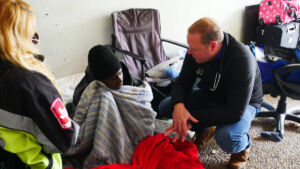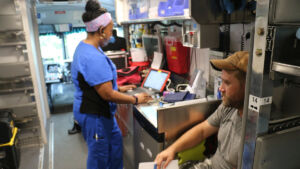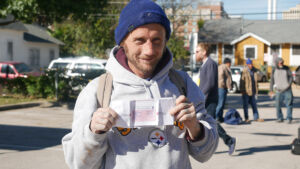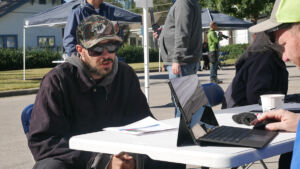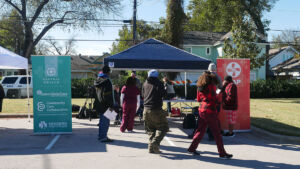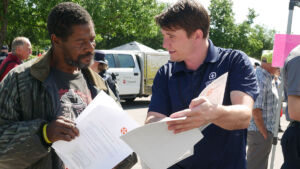March 27, 2024
Central Health grows and stretches out to address homelessness
Central Health, Travis County’s hospital district, is making healthcare better for all in this community, especially those who need it most. That includes thousands of residents who lack safe and stable housing, a crisis that’s vexed local leaders and stretched social services to the breaking point.
Poor health is a huge contributor to Austin’s homelessness crisis. People who are sick can’t work and pay rent. Living without stable housing is unsafe and exposes people to myriad health hazards. Many who are living in shelters or on the streets already have unmanaged chronic health conditions, compounded by trauma. Due to their living situation, their health just gets worse. Even people who have been moved into supportive housing may end up returning to the streets if their needs for healthcare are not properly met.
The Central Health system, including CommUnityCare and Sendero Health Plans, works collaboratively to develop and support the county’s safety-net healthcare system. By state law, the hospital district is responsible for meeting the healthcare needs of Travis County residents with low income, and the Central Health Board of Managers has committed to provide services, through a variety of programs, for residents with incomes at 200% or less of the federal poverty level.
How much is 200% of FPL? It’s just about $30,000 a year for a single adult, who according to housing experts could afford about $750/month in rent. The median one-bedroom rent in Austin in March 2024, according to RentCafe, is nearly twice that amount, $1,450/month.
That means housing instability is a fact of life for many of the nearly 300,000 Travis County residents in the income ranges served by Central Health. The hospital district, CommUnityCare, and their partners at Integral Care (Austin’s local mental health authority) keep that fact in mind as they develop and refine services that address the unique health needs and concerns of people experiencing homelessness.
These include:
- Mobile crisis outreach and street medicine teams
- Services through the At Home program for newly placed residents of permanent supportive housing.
- Medication-assisted treatment using methadone or buprenorphine for patients with opioid use disorder, along with the widespread distribution of the overdose rescue remedy naloxone (Narcan)
- Care and case management at local hospitals and skilled nursing facilities
- Transitional dialysis in dedicated spaces outside the hospital setting that allow patients a place to rest, recover and receive education and emotional support
- Specialty care services, including podiatry and HIV treatment, at the Care Connections (CareCo) clinic in South Austin.
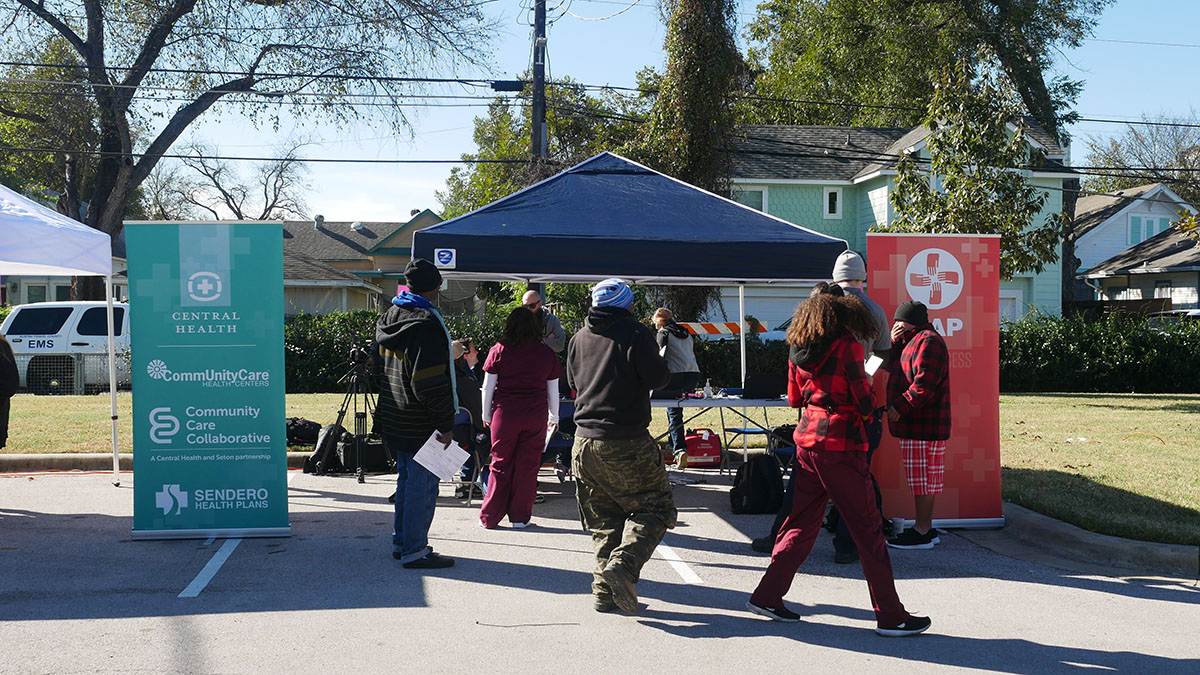
It also includes one of Central Health’s fastest growing and most successful service lines, known as medical respite. The street is not just a harmful place to live, but also a lousy place to try to recover from illness or injury. The hospitals know this: “When I discharge someone back to the street, I know they will be back.”
Central Health’s outreach workers and CommUnityCare’s street medicine teams know this: “It’s traumatic to find someone who needs shelter and medical rest, when we have no options for them.”
And those living without shelter in Travis County know this: “I have nowhere to be healthy, and I have nowhere to be sick.”
Those quotes were shared with Central Health’s Board of Managers by Dr. Audrey Kuang, who manages the medical respite program. As for her perspective, Kuang said, “The fact that basic shelter is standing in the way of thriving and improved health is an unacceptable truth to me. The alternative is not trivial, as this includes amputations or delayed cancer treatment or progression of chronic illnesses like cirrhosis or heart failure.” Both national and Central Texas data show a significantly reduced likelihood of readmission for patients who receive respite care.
Kuang made it her mission to build a medical respite program when she came to Austin in 2017, a vision that came true when she joined Central Health in 2021 as its director of high-risk populations. The medical respite program provides short-term residential care which gives individuals who are experiencing homelessness a safe place to rest, recover and heal. While in the program, patients can access clinical care, health education supportive services (benefits, housing assistance) that can help sustain their health moving forward.
The program opened in March 2022 with 5 beds at one location – A New Entry, Inc, a treatment and sober living facility which describes itself as a “trauma transformation center. Kuang had one staff member (a social worker) and one referral pathway from skilled nursing.
Now, two years later, the medical respite team includes nurses, medical assistants, community health workers and a social worker and has a capacity of 25 beds over three locations: ANE in East Austin, the Austin Resource Center for the Homeless (ARCH) downtown on E. Seventh, and the new city-run center at the Convention Center’s Marshalling Yard, near the airport.
Referrals have expanded to include hospitals and primary and specialty medical clinics, including CommUnityCare’s street medicine and mobile teams. All told, the respite program has received more than 400 referrals in its two years of existence, with 170 patients placed in respite care. Patients stay on average 32 days, but stays can range from a few days to many months. The most common diagnoses include cancer, fractures, skin infections and congestive heart failure.
Patients staying in medical respite can work with the team on finding housing (beginning with a “coordinated assessment,” Travis County’s centralized housing assistance application), obtaining benefits, ID cards, and other social drivers of health. Clinical care onsite includes basic wound care, vital signs and glucose monitoring. Patients get help with follow-up appointments and establish a medical home with a primary care physician if they need to. Kuang explained, “It’s much easier to help an individual with appointments, transportation, referrals and applications when you can find them, and they have less to worry about now they have a safe place to stay.”
Central Health plans for the medical respite program to grow even further by 2025, as the hospital district builds a 50-bed permanent respite facility at the Cameron Center property it purchased last year. The vision for the three-building complex at U.S. 183 and Cameron Road in Northeast Austin also includes a high-risk medical clinic and in- and outpatient substance use treatment, which address complex medical and behavioral health conditions that become more acute the longer people don’t have stable housing.
Many people experiencing homelessness do have jobs, and some even have health insurance through those jobs. Others have access to benefits that they’re not using, such as through the Veterans Administration. Others have Social Security disability payments, which makes them eligible for Medicaid and Medicare.
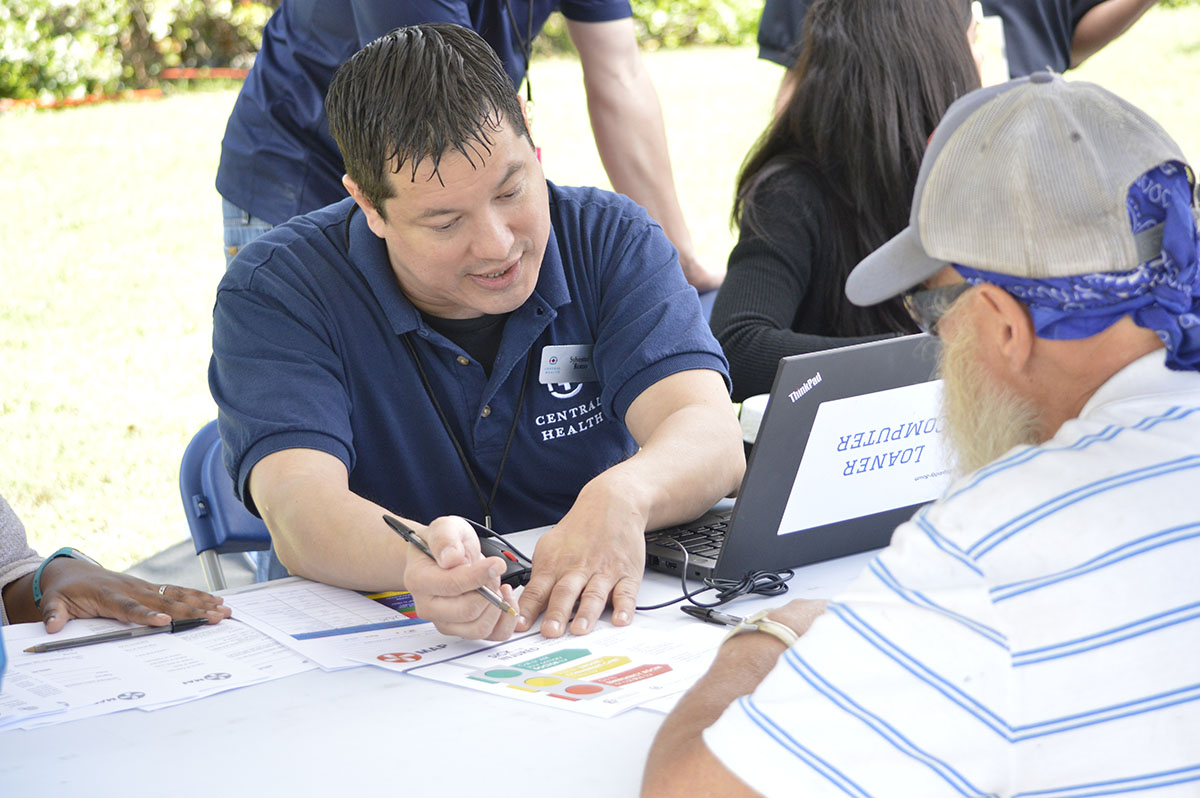
That still leaves a lot of people in Travis County without homes and without health coverage, including those who may have been housed until recently but have not been insured for a while. Their only portals to healthcare are hospital emergency rooms (for which the costs are high and the outcomes often poor) or by securing coverage through Central Health’s Medical Access Program (MAP), which waives all copays for patients without housing and covers medical transportation costs for patients.
On most days Central Health outreach specialists – certified Community Health Workers, all bilingual – can be found at places where low-income and unhoused Austinites gather: library branches, community kitchens, church-based relief programs, Ascension and St Davids hospitals, EMS ambulances, the county jail and Downtown Austin Community Court, the Mexican consulate, Austin Community College campuses, and other locales where Central Health has forged partnerships. Many neighbors they encounter in these settings need guidance and education about what MAP is and does, and they may need further help to apply online from a public computer.
In other cases, Central Health can deploy outreach specialists with the tools for what’s called “point of service” MAP application, which allows unhoused patients to apply using a single form, with live help from Central Health’s outreach and eligibility teams to track down and print out documents needed to establish eligibility. This hands-on process allows Central Health’s reviewers to establish eligibility sometimes that same day, always within a couple of days. Ultimately, outreach workers would like to be able to complete enrollments and print out new members’ MAP cards on the spot.
“The most rewarding part of my job is seeing the gratitude in our patients’ faces,” said Central Health outreach supervisor Aida Cerda-Prazak.” Some get very emotional when we are able to print out their documents that have been lost or stolen. With those printed copies, they are able to get new IDs and they feel more empowered. They have an identity, a story. They matter.“

